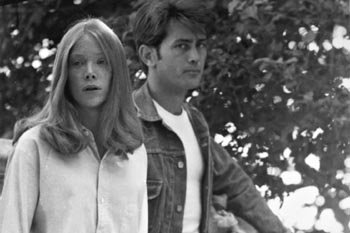With Malick Aforethought
Terrence Malick's dreamlike 'Badlands' looks even better 25 years later
You need to see some of the many imitations of Badlands just to realize how good a film it is. Fortunately, in the last 25 years, there have been dozens of pastiches of writer-director Terrence Malick's 1973 classic: Natural Born Killers, Butterfly Kiss, Kalifornia, The Doom Generation and many other nameless movies about young killers on the road, presented as cheap thrills or as social commentary of the "we are all murderers" variety.
Badlands, which gets a much-deserved reconsideration Feb. 13-19 at the Castro Theater, is neither a thriller nor a satire. It's more of a mystery: it shows a killing spree and asks you to guess why it happened. The film is based on the story of Charles Starkweather, who went haywire with a rifle in Nebraska in the 1950s and then hit the road with his girlfriend until he was caught.
Malick's directorial debut, as remarkable as it was, gained even more of a cult reputation because he made but one more film, Days of Heaven (1978), and then pulled a J.D. Salinger for the next 20 years, becoming the most noted cinematic recluse since Greta Garbo. (Malick is finally back, currently working on a WWII picture.) Watching the compelling, complicated Badlands, you can see why fans have been waiting for Malick to resurface.
This highly romanticized, fictionalized version of Starkweather's crimes is paradoxically blank and unnuanced, a puzzle with some pieces missing. Even the soundtrack, usually a guide in such matters, doesn't give us any clues about Malick's opinion of his two main characters. The music was picked for its very lack of suggestiveness: some marimba, some Erik Satie, some gamelan, a couple of '50s tunes (Mickey and Sylvia's odd duet "Love Is Strange" and Nat King Cole's "A Blossom Fell").
For a change, the narration does not serve as a last-minute patch job. Among other things, Badlands is an effort to get you under the skin of a woman who loves a man so uncritically that she doesn't even really notice that he's a homicide. Sissy Spacek's Holly, who accompanies the ex-garbage man Kit (a young, virile Martin Sheen) on his killing spree, tells her story in voice-over, as if it were a girl's confession for a True Life romance magazine. After making the criminal understatement "Kit was the most trigger-happy man I'd ever met," Holly follows Kit passively, obediently, as he kills six people.
One big piece of the puzzle is the motive of Holly's father, Mr. Sargis (Warren Oates), a sign painter, a craftsman. He knows enough about the world to recognize immediately that Kit is trouble; indeed, he's the only one in the film who does. To punish his daughter for seeing the boy, he shoots her pet dog. From Holly's lack of reaction, it's easy to figure out that this is not the first time Holly's been punished like that. Life with her father must have been wounding, something that made Holly shut up and close down when men rage--but what else such a life entailed, you have to guess.
In this dreamlike story of murder and flight, Malick doesn't work the typical gaffs of the modern serial-killer movie. Kit lacks the expected Freudian problems. It's Malick's decision that Kit and Holly's sex life is nothing you could base an opera on, and he doesn't blame society or the ugliness of people for their crimes. (In Oliver Stone's Natural Born Killers and Michael Winterbottom's Butterfly Kiss, all the murder victims are old, lecherous or fat.) It's as if the narcissistic pair have made a decision to grab romantic annihilation through perfect love. Without really knowing or feeling that kind of love, the two decide to shoot themselves but hit other people by mistake.
Badlands is a handsome, lyrical film. Malick's three photographers (Stevan Larner, Brian Probyn, and Tak Fujimoto, Jonathan Demme's usual cinematographer) present the arid immensity of the Great Plains memorably. That empty landscape matches the spare, almost murmured dialogue, but there are also oasislike spots of lushness. After the death of Holly's father, there's an interlude in a treehouse by a slow river. For lazy beauty and tension, these are scenes directors ought to aim for when filming Huckleberry Finn.
This somber fantasy of anarchy is fleet and sharp, a critique of doomed romance and the mythology of the handsome killer. Kit occasionally stops to make recordings of his voice for posterity; his confessions are a kid's idea of what an outlaw would say. They are the other half of Holly's own emotionless recital of lines like "He would die with me, and I wanted to die in his arms."
So many tombstones could bear the epitaph "The Wrong Place at the Wrong Time." Badlands is about that traditional explanation for why someone ends up murdered. Kit is actually kind of a nice guy when he doesn't have a gun in his hands. The police finally end the chase--and show no malice when they do. They know that Kit's a big story they can tell their kids, and they're happy to have souvenirs of the killer. But they aren't really angry at him. It's as if this sort of thing happens all the time.
[ San Francisco | MetroActive Central | Archives ]
Copyright © Metro Publishing Inc.
![]()

Home on the Shooting Range: Sissy Spacek and Martin Sheen forge a bloody trail through Terrence Malick's 'Badlands.'
From the February 1998 issue of the Metropolitan.
![[MetroActive Movies]](/movies-arts-entertainment/gifs/movies468.gif)